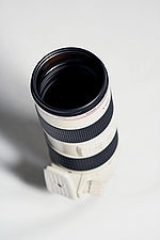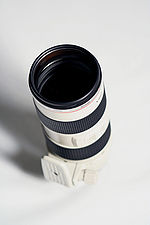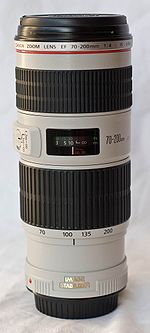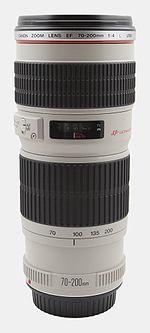
Canon EF 70-200mm lens
Encyclopedia
The EF 70-200mm lens is a telephoto
zoom
lens
made by Canon Inc.
The lens has an EF
mount to work with the EOS
line of cameras.
The lens comes in five different versions, all of which have fixed maximum aperture
at all focal length
s and are L-series lenses.2.8L IS
USM
2.8L IS II USM2.8L USM4L IS USM4L USM
The 4 non-IS version, the cheapest L-series lens that Canon makes, is popular among weight-sensitive landscape photographers and hobbyists who want L lens quality without spending thousands of dollars. The 2.8 versions are popular among event photographers and photojournalists; some portrait photographers also prefer this lens. The IS version lenses use circular 8-bladed diaphragms which maintain a nearly circular aperture when stopped down by up to two stops. The 2.8 and 4.0 image-stabilized versions also feature weather sealing (resistance to dust and water) when used with a weather sealed camera to match such as the 5D Mark II
; weather sealed Canon products are not completely sealed from the environment, they are merely more resistant than non-sealed versions. These lenses are compatible with the Canon Extender EF
teleconverters.
of this lens is equivalent to a 112-320mm on an APS-C sensor, or 91-260mm on an APS-H sensor. This is due to the crop factor
inherent with APS-C or APS-H (crop) sensor digital SLR cameras.
. In recognition of this issue, the most recent of these lenses (the f/4L IS USM model and recent f/2.8L IS USM lenses) uses switches designed to reduce the incidence of accidental switch activation http://www.canon.com/camera-museum/tech/report/200611/report.html#t14.
Telephoto lens
In photography and cinematography, a telephoto lens is a specific type of a long-focus lens in which the physical length of the lens is shorter than the focal length. This is achieved by incorporating a special lens group known as a telephoto group that extends the light path to create a long-focus...
zoom
Zoom lens
A zoom lens is a mechanical assembly of lens elements for which the focal length can be varied, as opposed to a fixed focal length lens...
lens
Photographic lens
A camera lens is an optical lens or assembly of lenses used in conjunction with a camera body and mechanism to make images of objects either on photographic film or on other media capable of storing an image chemically or electronically.While in principle a simple convex lens will suffice, in...
made by Canon Inc.
Canon Inc.
is a Japanese multinational corporation that specialises in the manufacture of imaging and optical products, including cameras, camcorders, photocopiers, steppers and computer printers. Its headquarters are located in Ōta, Tokyo, Japan.-Origins:...
The lens has an EF
Canon EF lens mount
Introduced in 1987, the EF lens mount is the standard lens mount on the Canon EOS family of SLR film and digital cameras. EF stands for "Electro-Focus": automatic focusing on EF lenses is handled by a dedicated electric motor built into the lens...
mount to work with the EOS
Canon EOS
The Canon EOS autofocus 35 mm film and digital SLR camera system was introduced in 1987 with the Canon EOS 650 and is still in production as Canon's current DSLR system...
line of cameras.
The lens comes in five different versions, all of which have fixed maximum aperture
Aperture
In optics, an aperture is a hole or an opening through which light travels. More specifically, the aperture of an optical system is the opening that determines the cone angle of a bundle of rays that come to a focus in the image plane. The aperture determines how collimated the admitted rays are,...
at all focal length
Focal length
The focal length of an optical system is a measure of how strongly the system converges or diverges light. For an optical system in air, it is the distance over which initially collimated rays are brought to a focus...
s and are L-series lenses.2.8L IS
Image stabilization
Image stabilization is a family of techniques used to reduce blurring associated with the motion of a camera during exposure. Specifically, it compensates for pan and tilt of a camera or other imaging device. It is used in image-stabilized binoculars, still and video cameras, and astronomical...
USM
Ultrasonic motor
An ultrasonic motor is a type of electric motor powered by the ultrasonic vibration of a component, the stator, placedagainst another component, the rotor or slider depending on the scheme of operation...
2.8L IS II USM2.8L USM4L IS USM4L USM
The 4 non-IS version, the cheapest L-series lens that Canon makes, is popular among weight-sensitive landscape photographers and hobbyists who want L lens quality without spending thousands of dollars. The 2.8 versions are popular among event photographers and photojournalists; some portrait photographers also prefer this lens. The IS version lenses use circular 8-bladed diaphragms which maintain a nearly circular aperture when stopped down by up to two stops. The 2.8 and 4.0 image-stabilized versions also feature weather sealing (resistance to dust and water) when used with a weather sealed camera to match such as the 5D Mark II
Canon EOS 5D Mark II
The Canon EOS 5D Mark II is a 21.1-megapixel full-frame CMOS digital single-lens reflex camera made by Canon. It succeeds the EOS 5D and was announced on September 17, 2008.-Improvements compared to original EOS 5D:...
; weather sealed Canon products are not completely sealed from the environment, they are merely more resistant than non-sealed versions. These lenses are compatible with the Canon Extender EF
Canon Extender EF
The Extender EF lenses are a group of teleconverter lenses made by Canon. These lenses are used between any compatible EF type lens and any of the Canon EOS line of cameras. When used with a compatible lens, such as the Canon EF 500mm 4L IS USM, they will multiply the focal length of the lens by a...
teleconverters.
Crop factor
When used with a Canon APS-C (1.6x crop) DSLR camera or APS-H (1.3x crop), the field of viewField of view
The field of view is the extent of the observable world that is seen at any given moment....
of this lens is equivalent to a 112-320mm on an APS-C sensor, or 91-260mm on an APS-H sensor. This is due to the crop factor
Crop factor
In digital photography, a crop factor is related to the ratio of the dimensions of a camera's imaging area compared to a reference format; most often, this term is applied to digital cameras, relative to 35 mm film format as a reference. In the case of digital cameras, the imaging device would be a...
inherent with APS-C or APS-H (crop) sensor digital SLR cameras.
Switches
The most frequently pointed-out problem with this lens is the placement of the IS and AF buttons, that makes them prone to accidental flipping during hand-held shooting. Some photographers solve this simply by covering the buttons with a piece of gaffer tapeGaffer tape
Gaffer tape, gaffer's tape, gaff tape or gaffa tape is a strong, tough, cotton cloth pressure sensitive tape with strong adhesive properties. It is used in theater, film and television productions as well as during live performances and any other kind of stage work...
. In recognition of this issue, the most recent of these lenses (the f/4L IS USM model and recent f/2.8L IS USM lenses) uses switches designed to reduce the incidence of accidental switch activation http://www.canon.com/camera-museum/tech/report/200611/report.html#t14.
Specifications
| Attribute | f/2.8L IS USM II | f/2.8L IS USM | f/2.8L USM | f/4L IS USM | f/4L USM |
|---|---|---|---|---|---|
| Image |  |
 |
 |
 |
|
| Image stabilizer |  |
 |
 |
 |
 |
| Environmental Sealing |  |
 |
 |
 |
|
| Ultrasonic Motor |  |
||||
| L-series |  |
||||
| Diffractive Optics |  |
||||
| Macro Macro photography Macrophotography is close-up photography, usually of very small subjects. Classically a macrophotograph is one in which the size of the subject on the negative is greater than life size. However in modern use it refers to a finished photograph of a subject at greater than life size... |
 |
||||
| Maximum aperture Aperture In optics, an aperture is a hole or an opening through which light travels. More specifically, the aperture of an optical system is the opening that determines the cone angle of a bundle of rays that come to a focus in the image plane. The aperture determines how collimated the admitted rays are,... |
2.8 | 4 | |||
| Minimum aperture Aperture In optics, an aperture is a hole or an opening through which light travels. More specifically, the aperture of an optical system is the opening that determines the cone angle of a bundle of rays that come to a focus in the image plane. The aperture determines how collimated the admitted rays are,... |
32 | ||||
| Weight | 1490 g (3.3 lb) | 1470 g (3.2 lb) | 1310 g (2.9 lb) | 760 g (1.7 lb) | 705 g (1.6 lb) |
| Maximum diameter | 89 mm (3.5 in) | 86 mm (3.4 in) | 85 mm (3.3 in) | 76 mm (3 in) | |
| Length | 197 mm (7.8 in) | 197 mm (7.8 in) | 194 mm (7.6 in) | 172 mm (6.8 in) | |
| Filter diameter | 77 mm | 67 mm | |||
| Lens hood Lens hood In photography, a lens hood or lens shade is a device used on the end of a lens to block the sun or other light source in order to prevent glare and lens flare.... |
Tulip-shaped (ET-86) | Tulip-shaped (ET-83II) | Cylindrical (ET-74) | ||
| Horizontal viewing angle Angle of view In photography, angle of view describes the angular extent of a given scene that is imaged by a camera. It is used interchangeably with the more general term field of view.... |
29° – 10° | ||||
| Vertical viewing angle Angle of view In photography, angle of view describes the angular extent of a given scene that is imaged by a camera. It is used interchangeably with the more general term field of view.... |
19°30′ – 7° | ||||
| Diagonal viewing angle Angle of view In photography, angle of view describes the angular extent of a given scene that is imaged by a camera. It is used interchangeably with the more general term field of view.... |
34° – 12° | ||||
| Groups/elements | 19/23 | 18/23 | 15/18 | 15/20 | 13/16 |
| # of diaphragm Diaphragm (optics) In optics, a diaphragm is a thin opaque structure with an opening at its center. The role of the diaphragm is to stop the passage of light, except for the light passing through the aperture... blades |
8 | ||||
| Closest focusing distance | 1.2 m (3.9 ft) | 1.4 m (4.6 ft) | 1.5 m (4.9 ft) | 1.2 m (3.9 ft) | |
| Release date | April 2010 | September 2001 | March 1995 | November 2006 | September 1999 |
| MSRP Suggested retail price The manufacturer's suggested retail price , list price or recommended retail price of a product is the price which the manufacturer recommends that the retailer sell the product. The intention was to help to standardise prices among locations... $ United States dollar The United States dollar , also referred to as the American dollar, is the official currency of the United States of America. It is divided into 100 smaller units called cents or pennies.... |
$2,499.00 | $1,999.00 | $1,449.00 | $1,349.00 | $710.00 |
See also
- Canon lenses
- Canon EF 16-35mm lensCanon EF 16-35mm lensThe EF 16-35mm 2.8L USM lens is a professional wide-angle lens made by Canon Inc. It replaced the EF 17-35mm 2.8L USM lens, which had itself replaced the EF 20-35 2.8L lens.The lens has an EF mount to work with the EOS line of cameras...
, with the same maximum aperture of 2.8. Serves as a ultra wide-angle to complement the 70-200mm. This combination is commonly used by Photojournalists. - Canon EF-S 17–55mm lens, with the same maximum aperture of 2.8. Compatible only with Canon APS-C bodies (1.6x crop factor). General-purpose zoom to complement the 70-200mm; this combination is used by some owners of higher-end APS-C bodies.
- Canon EF 24-70mm lens, with the same maximum aperture of 2.8. Serves as a general-purpose lens to complement the 70-200mm. This combination is commonly used by wedding photographers.
- Canon EF 16-35mm lens
- Third party lenses
- Sigma 70-200mm f/2.8 EX lens

